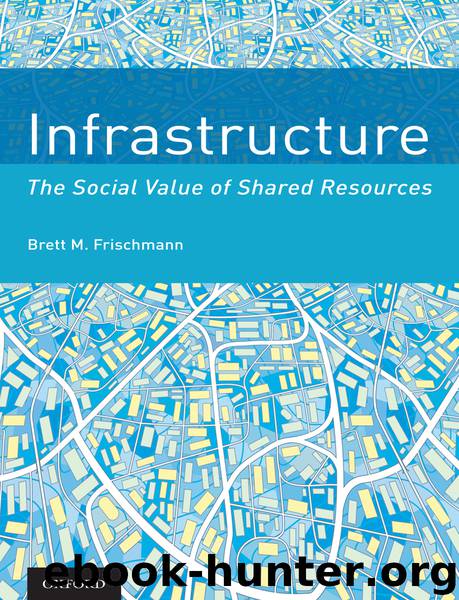Infrastructure by Frischmann Brett M

Author:Frischmann, Brett M.
Language: eng
Format: epub
Tags: The Social Value of Shared Resources
Publisher: Oxford University Press, USA
Published: 2012-03-24T16:00:00+00:00
D. Multiple-Use Management and Ecosystem Services
The concept of environmental infrastructure seems to fit well within existing environmental scholarship. Specifically, it appears to complement bodies of work on (1) multiple-use management (MUM) strategies for public lands and forests, and (2) ecosystem valuation and management.78
MUM primarily focuses on valuing and managing natural resources that have multiple competing human uses.79 Different sets of uses are characterized and valued under different scenarios; where uses are rival, the different scenarios consider shared but coordinated use versus dedicated use. In managing a forest unit, for example, one would compare the net benefits of joint production of timber and recreational amenities with the net benefits of dedicating the unit to a “dominant use” (timber production or recreation).80 MUM does not directly incorporate ecosystems services as a set of “uses” within the multiple-use framework.81 This is a potential shortcoming when one considers the complex interaction of nonhuman users and infrastructures and increasing concerns about long-term sustainability. In her critique of a MUM approach, Janet Neuman argues that “the Tillamook State Forest ecosystem is much greater than the sum of its parts. Until a true ecosystem approach is adopted, the forest managers, the interest groups, and the public will all fail to see the forest for the trees … or the fish … or the off-road-vehicle trails … or any other single interest.”82 MUM has evolved to incorporate some ecosystem planning and management principles.83
The ecosystems literature brings together resource management perspectives in economics, ecology, and other related fields and takes a more holistic view of systems of nonliving environmental resources and the living resources that support and are supported by the environment.84 Economists attempt to value a wide range of ecosystem services, some of which involve direct human agency in the exploitation and use of the resource and some of which involve nonhuman agency and indirect provision of services. As discussed, these services can be split into direct market, direct nonmarket, and indirect nonmarket uses. The first category involves value that is well reflected in markets; the latter two categories do not. As a result, valuing ecosystem services typically relies on nonmarket valuation methods (e.g., revealed preference methods, stated preference methods, and avoided and replacement cost methods). Ruhl observes, “Each technique has its own set of limitations, but each can also reveal the tremendous monetary values of ecosystem services that are currently ‘hidden’ from the marketplace. Given the level of knowledge about ecosystem services that members of society have at any time, the results of these techniques are first approximations of the values assigned by individuals to ecosystems services and the functions they perform.”85
Built on an understanding that the methods are imperfect, that trade-offs are inevitable, and that “society has to choose how to allocate natural resources necessarily requires valuation of ecosystem services in some form or another,”86 the literature reflects a concerted effort to grapple with the complex systems involved, to improve economic valuation methods, and gradually to improve decision-making processes and regulatory frameworks.87 The idea that priorities
Download
This site does not store any files on its server. We only index and link to content provided by other sites. Please contact the content providers to delete copyright contents if any and email us, we'll remove relevant links or contents immediately.
International Integration of the Brazilian Economy by Elias C. Grivoyannis(57319)
The Radium Girls by Kate Moore(10907)
Turbulence by E. J. Noyes(7037)
Nudge - Improving Decisions about Health, Wealth, and Happiness by Thaler Sunstein(6633)
The Black Swan by Nassim Nicholas Taleb(6190)
Pioneering Portfolio Management by David F. Swensen(5605)
Rich Dad Poor Dad by Robert T. Kiyosaki(5147)
Zero to One by Peter Thiel(4823)
Man-made Catastrophes and Risk Information Concealment by Dmitry Chernov & Didier Sornette(4735)
Secrecy World by Jake Bernstein(3782)
Millionaire: The Philanderer, Gambler, and Duelist Who Invented Modern Finance by Janet Gleeson(3568)
Skin in the Game by Nassim Nicholas Taleb(3459)
The Age of Surveillance Capitalism by Shoshana Zuboff(3421)
The Money Culture by Michael Lewis(3284)
Skin in the Game: Hidden Asymmetries in Daily Life by Nassim Nicholas Taleb(3264)
Bullshit Jobs by David Graeber(3179)
The Dhandho Investor by Mohnish Pabrai(3167)
The Wisdom of Finance by Mihir Desai(3077)
Blockchain Basics by Daniel Drescher(2890)
